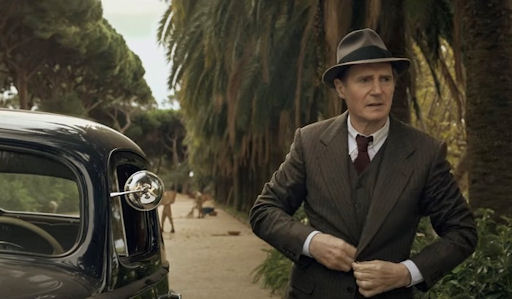
Let me introduce you to something interesting. We’ll call it “The Case of Three Marlowes.”
Once upon a time in California, way back in 1939, a detective fiction writer by the name of Raymond Chandler, published a novel, “Farewell, My Lovely,” featuring the private investigator Philip Marlowe. This, and seven novels that followed, had an outsized stylistic influence on popular literature right down to today. Philip Marlowe is a perfect example of the hard-boiled detective: a cynical man fighting both criminals and a corrupt legal system. This detective is none too clean himself, but at the core he does have an ethical basis for his behavior.
This was the right material for the burgeoning “film noir” genre and in 1944 Philip Marlowe first hit the silver screen in RKO’s “Murder, My Sweet.” The principal character was played by Dick Powell, (“Gold Diggers of 1937”), who’d been a pretty-boy star of musicals and comedies up to that point. The result was a sensation, and one of the best of the genre. Also prominent in the film were Otto Kruger (“Saboteur”), as a scheming pseudo-psychoanalyst – “I am, in short, a quack” – and drug purveyor to the wealthy.
Former wrestler turned actor Mike Mazurki (“The Canterville Ghost”) played Moose Malloy, a dimwitted ex-con searching for the girl he went to prison for. And Claire Trevor (“Stagecoach”) was that girl – the quintessential noir femme fatale whose actions get the whole complex, murderous plot rolling. Together with the brisk action and very snappy dialogue, these four “made” the picture. They are supported by many other interesting characters.
The film was shot in black and white, with plenty of shadow, an edgy score, gritty vs glamorous locales, and excellent acting. Chandler was purportedly pleased with this first celluloid appearance of his detective anti-hero.
 Flash forward, past many other adaptations of Chandler’s works, to 1969. Chandler himself has been dead for 10 years. James Garner (“Maverick”), appears in the film “Marlowe,” which is based on Chandler’s 1949 novel “The Little Sister.” Like “Farewell, My Lovely,” the book is considered one of the author’s best. Screenwriter Stirling Silliphant (“In the Heat of the Night”), updates the story by 20 years, adding hippies, TV stars, and other more modern accretions. The noir black and white of Powell’s day has been replaced by full technicolor, but the snappy dialogue and cast of peculiar characters remains.
Flash forward, past many other adaptations of Chandler’s works, to 1969. Chandler himself has been dead for 10 years. James Garner (“Maverick”), appears in the film “Marlowe,” which is based on Chandler’s 1949 novel “The Little Sister.” Like “Farewell, My Lovely,” the book is considered one of the author’s best. Screenwriter Stirling Silliphant (“In the Heat of the Night”), updates the story by 20 years, adding hippies, TV stars, and other more modern accretions. The noir black and white of Powell’s day has been replaced by full technicolor, but the snappy dialogue and cast of peculiar characters remains.
Garner plays a lighter, more humorous, less gritty version of Marlowe, but still has his grim morality intact. Other characters include angry, resentful Lt. Christy French (Carroll O’Connor – “All in the Family”), smooth criminal boss Sonny Steelgrave (J.M. Wynant – “Footprints”), deceptively loyal but scheming femme fatale Dolores Gonzales (Rita Moreno – “West Side Story”), and martial arts enforcer Winslow Wong (Bruce Lee – “Enter the Dragon”). There are many others, creating a rich stew of characters, red herrings, and unexpected plot shifts.
The film’s opening credits play over a catching tune, “Little Sister,” which becomes the background theme up through a splashy reprise at the end. Too upbeat for noir, but just right for the ‘60s.
Now, we come to 2023. Chandler has been dead longer than he lived – he was 59 when he died and it’s been 64 years since then. In this offering, also titled “Marlowe,” veteran actor Liam Neeson (“Kinsey”) plays an older version of the detective. This would make more sense if the story didn’t take place when Marlowe should have been in his prime – 1939. It’s a new story in the style and using the characters of Chandler, but written by someone else.
The movie is based on John Banville’s 2014 “The Black Eyed Blonde.” Banville is not the only one to take a crack at carrying on the Chandler legacy. Before him was Robert B. Parker who completed Chandler’s “Poodle Springs” and then wrote the original “Perchance to Dream.” After Banville came Lawrence Osborne with “Only to Sleep,” and most recently came Joe Ide with “The Goodbye Coast.”
Banville’s book was set in the 1950s, when Chandler was still turning them out, but the movie producers had it retrogressed to 1939 when Chandler was presumably completing the details for a more vigorous, grittier Marlowe.
Rather than go either b&w or technicolor, we are treated to a sepia-toned nightmare akin to viewing your Kodachrome wedding pictures through dark glasses after 40 years of sun exposure. The pace is glacial for the most part, and the dialogue is Chandler run through a laudromat. Sadly, Liam Neeson alternates between an almost grandfatherly courtesy and simplicity, and the violent creature he’s better known for in other pictures. Grandpa in a rocker armed with a killer punch.
Directed by Neil Jordan (“The Crying Game”) – who previously has written and directed poignant films with exquisitely developed characters – the results are disappointing. And he being the co-writer, there is nowhere else to lay the blame. Given the sluggish pace of most of the 110-minute film, he should have found time to give us the fully dimensional characters we deserve.
That is not to say there aren’t a few entertaining flickers in the murk. The character of Lou Hendricks, a self-styled philosopher and drug importing gangster from Louisiana, is admirably written, and charmingly portrayed by Alan Cummings (“Goldeneye”). And Danny Huston (“We Are Gathered Here Today”) superbly plays Floyd Hanson, the manager of an exclusive club accessible only to the rich and famous. He veritably drips with unctuous evil. One of the best scenes of the film is when he bends over a supposedly dying Marlowe, delivering a brief soliloquy as he tenderly lowers his victim’s head onto a couch.
Finally, there is a delicious but brief reference to the “Ambassador,” an equal opportunity lecher obviously representing Joseph P. Kennedy Sr. The US diplomat to Great Britain is only given a few seconds of screen time. Aside from these, there are few other interesting characters; so different from the previous movies and Chandler’s novels.
The women, played by Diane Kruger (“In the Fade”) and Jessica Lange (“American Horror Story”) are mildly interesting, but their characters cannot compete with the “baddies” listed above. No true femme fatale here. Lastly, not only has Marlowe lost much of his clever dialogue and most of his vigor, he has abandoned his moral code. See the movie and decide for yourself.
On second thought, maybe that loss of grounding is the essence of 2023 film noir.
Finally, all these adaptation vary from the source material in some ways – they either drop or sanitize some portions of the story (in the case of “Murder, My Sweet”), add material to enhance the drama (in the case of “The Little Sister”), or simply adapt the adaptation (“Marlowe”).
So what are we to make of all this? It is pretty apparent that, as we move further from the original source material, either through updating the material or creating a pastiche, we lose more and more of what made Chandler, and Philip Marlowe great. With all the other hardboiled detective stories out there, why take a great one and make egg salad?

Some interesting side notes (if you are into those things):
-
• Otto Kruger plays Jules Amthor in “Murder, My Sweet” and Diana Kruger plays Clare Cavendish in “Marlowe: (2023).
• “Murder, My Sweet” was released by RKO. Joseph P. Kennedy Sr. was instrumental in creating RKO.
• All three movies take place in Los Angeles (sometimes referred to by Chandler as “Bay City,” which also refers to Santa Monica). The first two were indeed filmed there, but the third was filmed in Spain and Ireland, which stood in for LA locales.
• Jessica Lange’s character is loosely based on Gloria Swanson, who carried on a three-year affair with that married father of eight, Joseph P. Kennedy Sr. However, Swanson was 40 at the time “Marlowe” is set, whereas Lange was 70 when this film was produced.
• Danny Huston (son of the famous director John Huston, who did a number of noir pictures) plays a post Hays Office version of Jules Amthor in “Marlowe” (2023).
• “Marlowe” (1969) director Paul Bogart also subsequently directed actor Carroll O’Connor in “All in the Family.”
. . .
Join us on Facebook at
http://www.facebook.com/itsjustmovies!